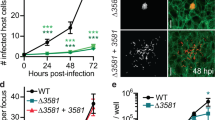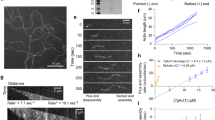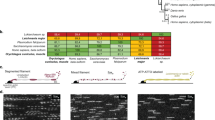Abstract
The pathogenic bacterium Listeria monocytogenes is capable of directed movement within the cytoplasm of infected host cells. Propulsion is thought to be driven by actin polymerization at the bacterial cell surface1,2, and moving bacteria leave in their wake a tail of actin filaments3. Determining the mechanism by which L. monocytogenes polymerizes actin may aid the understanding of how actin polymerization is controlled in the cell. Actin assembly by L. monocytogenes requires the bacterial surface protein ActA4,5 and protein components present in host cell cytoplasm. We have purified an eight-polypeptide complex that possesses the properties of the host-cell actin polymerization factor. The pure complex is sufficient to initiate ActA-dependent actin polymerization at the surface of L. monocytogenes, and is required to mediate actin tail formation and motility. Two subunits of this protein complex are actin-related proteins (ARPs) belonging to the Arp2 and Arp3 subfamilies. The Arp3 subunit localizes to the surface of stationary bacteria and the tails of motile bacteria in tissue culture cells infected with L. monocytogenes; this is consistent with a role for the complex in promoting actin assembly in vivo. The activity and subunit composition of the Arp2/3 complex suggests that it forms a template that nucleates actin polymerization.
This is a preview of subscription content, access via your institution
Access options
Subscribe to this journal
Receive 51 print issues and online access
$199.00 per year
only $3.90 per issue
Buy this article
- Purchase on Springer Link
- Instant access to full article PDF
Prices may be subject to local taxes which are calculated during checkout
Similar content being viewed by others
References
Sanger, J. M., Sanger, J. W. & Southwick, F. S. Infect. Immun. 60, 3609–3619 (1992).
Theriot, J. A., Mitchison, T. J., Tilney, L. G. & Portnoy, D. A. Nature 357, 257–260 (1992).
Tilney, L. G. & Portnoy, D. A. J. Cell Biol. 109, 1597–1608 (1989).
Kocks, C. et al. Cell 68, 521–531 (1992).
Domann E. et al. EMBO 11, 1981–1990 (1992).
Theriot, J. A., Rosenblatt, J., Portnoy, D. A., Goldschmidt-Clermont, P. J. & Mitchison, T. J. Cell 76, 505–517 (1994).
Siegel, L. M. & Monty, K. J. Biochim. Biophys. Acta 112, 346–362 (1966).
Frankel, S. & Mooseker, M. Curr. Opin. Cell Biol. 8, 30–37 (1996).
Michaille, J. J., Gouy, M., Blanchet, S. & Duret, L. Gene 154, 205–209 (1995).
Tanaka, T. et al. Biochem. Biophys. Res. Commun. 187, 1022–1028 (1992).
Machesky, L. M., Atkinson, S. J., Ampe, C., Vandekerckhove, J. & Pollard, T. D. J. Cell Biol. 127, 107–115 (1994).
Kelleher, J. F., Atkinson, S. J. & Pollard, T. D. J. Cell Biol. 131, 385–397 (1995).
Zheng, Y., Wong, M. L., Alberts, B. & Mitchison, T. Nature 378, 578–583 (1995).
Moritz, M., Braunfeld, M. B., Sedat, J. W., Alberts, B. M. & Agard, D. A. Nature 378, 638–640 (1995).
Ruhnau, K., Gaertner, A. & Wegner, A. J. Mol. Biol. 210, 141–148 (1989).
Gaertner, A. & Wegner, A. J. Muscle Res. Cell Motil. 12, 27–36 (1991).
Moreau, V., Madania, A., Martin, R. P. & Winsor, B. J. Cell Biol. 134, 117–132 (1996).
McCollum, D., Feoktistova, A., Morphew, M., Balasubramanian, M. & Gould, K. L. EMBO 15, 6438–6446 (1996).
Chakraborty, T. et al. EMBO J. 14, 1314–1321 (1995).
Lasa, I., Violaine, D., Gouin, E., Marchand, J. B. & Cossart, P. Mol. Microbiol. 18, 425–436 (1995).
Smith, G. A., Theriot, J. A. & Portnoy, D. A. J. Cell Biol. 135, 647–660 (1996).
Schaier, S. R. Methods Enzymol. 215, 58–77 (1992).
Kellogg, D. R., Mitchison, T. J. & Alberts, B. M. Development 103, 675–686 (1988).
Murray, A. W. Methods Cell Biol. 36, 581–605 (1991).
Leimeister-Wachter, M. & Chakraborty, T. Infect. Immun. 57, 2350–2357 (1989).
Brundage, R. A., Smith, G. A., Camilli, A., Theriot, J. A. & Portnoy, D. A. Proc. Natl Acad. Sci. USA 90, 11890–11894 (1993).
Hirano, H. & Watanabe, T. Electrophoresis 11, 573–580 (1990).
Iwamatsu, A. Electrophoresis 13, 142–147 (1992).
Sawin, K. E., Mitchison, T. J. & Wordeman, L. G. J. Cell. Sci. 101, 303–313 (1992).
Symons, M. H. & Mitchison, T. J. J. Cell Biol. 114, 503–513 (1991).
Pistor, S., Chakraborty, T., Walter, U. & Wehland, J. Curr. Biol. 5, 517–525 (1995).
Author information
Authors and Affiliations
Rights and permissions
About this article
Cite this article
Welch, M., Iwamatsu, A. & Mitchison, T. Actin polymerization is induced by Arp 2/3 protein complex at the surface of Listeria monocytogenes. Nature 385, 265–269 (1997). https://doi.org/10.1038/385265a0
Received:
Accepted:
Issue Date:
DOI: https://doi.org/10.1038/385265a0
This article is cited by
-
The MEF2A transcription factor interactome in cardiomyocytes
Cell Death & Disease (2023)
-
Parkinson mice show functional and molecular changes in the gut long before motoric disease onset
Molecular Neurodegeneration (2021)
-
Cooperative epithelial phagocytosis enables error correction in the early embryo
Nature (2021)
-
Mechanistic insight into bacterial entrapment by septin cage reconstitution
Nature Communications (2021)
-
Emerging technologies and infection models in cellular microbiology
Nature Communications (2021)
Comments
By submitting a comment you agree to abide by our Terms and Community Guidelines. If you find something abusive or that does not comply with our terms or guidelines please flag it as inappropriate.



